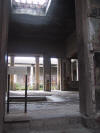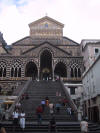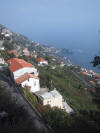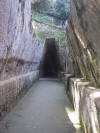| |
Had a great long week in the Gulf
of Naples area. While I enjoyed the area overall, the city of Naples (which
I luckily managed to largely avoid) is a different story (see my thoughts at
the end) |
 |
Sorrento. |
 |
Our hotel in Sorrento (www.ghpresident.com) |
 |
View over Sorrento from our
balcony |
 |
View from Punta Campanella (the
peak of the Sorrento peninsula) toward Amalfi Coast. On day 2 we further did
the rest of the Sorrento pensinsula (e.g. Massa Lubrense, Termini, Marina
del Cantone, S. Agata sui Due Golfi) |
 |
Pompeji with Vesuvius in the
background which on 24 August 79 A.D. covered Pompeji with meters of ashes (day
3) |
 |
It is actually amazing how well
everything is perserved. It is a full city with trade shops etc. |
 |
A thermal bath almost still
functional |
 |
A Roman city villa |
 |
Painting in a villa |
 |
Actually being on the Amalfi
coast driving towards Positano. On day 4 we drove along Amalfi Coast to
Amalfi and then via Ravello across a pass which led us back close to
Pompeji. |
 |
More impressions of this
adventurous road |
 |
Positano, my favorite place at
the Amalfi Coast |
 |
View back to Positano back on the
road towards Amalfi |
 |
Amalfi |
 |
The cathedral of Amalfi with many
Arab influences (ancient Amalfi was a sea-faring nation with many trade
connections to the Orient) |
 |
Capri as seen from Punta
Campanella |
 |
On day 5 we did the unavoidable
Capri trip with the even less unavoidable visit to the Blue Grotto |
 |
Blue Grotto |
 |
View from Monte Solaro (589m)
towards I Faraglioni |
 |
View down towards Marina Grande |
 |
What a great place to have a hot
chocolate and cake (Marina Piccola) |
 |
On day 6 we visited Vesuvius |
 |
View down to Naples |
 |
Interesting stone layers in the
crater |
 |
On the way back from Vesuvius we
actually did another pass into Amalfi Coast (via Agerola from where this
picture is taken). How can anybody come up with the idea to build houses and
a road on this steep slope? |
 |
On day 7 we drove all along the
Amalfi Coast to Salerno and then on to Paestum (i.e. also including the section between Amalfi and
Salerno, I actually ran from Maiori to Vietri sul Mare, a subrub of
Salerno along the road). On the picture we see Poseidon Temple one of the three extremely
well conserved temples in Paestum built 700 B.C.! In the background we see
the Basilica. |
 |
Ceres Temple |
 |
Posideon tempel again |
 |
On day 8 I went for the Sentiero
del Dei (God's track) hike between Agerola and Positano. The best thing I
did on the Amalfi Coast. View back towards Agerola. |
 |
View towards the Sorrento
peninsula |
 |
View down to Positano |
 |
On day 9: Sybil cave near Cuma on
the Campi Flegrei |
 |
Solfatara crater, it smelled very
stronly sulphur. Later we took the ferry to Ischia |
 |
Sunset over Castello Aragonese as
seen from our hotel room |
 |
Ischia Ponte just after sunset |
 |
Ischia Porto at dinner time |
 |
Sunrise over Castello Aragonese
on day 10, as seen from our balcony |
 |
Another great place to have a
drink (top of Castello Aragonese) |
 |
Ischia Ponte as seen from
Castello Aragonese |
 |
Spiaggia di Citara on Sunday
afternoon 16 October |
 |
Punta Sant'Angelo as seen from
Serrara |
 |
View over Sant'Angelo |
 |
On day 11 we took the ferry back
to the mainland to catch our plane and were passed by a hug cruise ship |
| |
Thoughts on Naples:
When the ancient Greek came to the Gulf
of Naples the first landed on an island inhabited by an ethnical tribe
called Italians, the Greek were so “impressed” with the state of development
of the Italians that they called the island Pithekoussai (The Island of the
Apes). Luckily the island has developed through tourism to what we today
know as the Island of Ischia.
Also during the times of the Romans
the region was not living up to the highest standards. After some terrible
brawl at the Amphitheatre of Pompeji in 59 A.D. all games were banned for 10 years.
When a severe earthquake heavily damaged Pompeji on 5 February 62 A.D. not
surprisingly the government in Rome didn’t find it worthwhile to make funds
available for reconstruction and development (for some reason the EU today
seems to have come to a different conclusion).
As a modern day tourist you can still
revive the ancient Greek experience when you arrive in the region through
the City of Naples. After you leave the micro-sized Airport to overlook
Naples and its suburbs you see the smoke of fires everywhere. I have never
found out what is actually being burnt but I assume that it is the trash
which the Napolitanians have not used to litter every view point and every
square meter along the streets and highways. Put this together with the
beggars and the boys at the highway toll stations trying to sell tissues and
you feel like in India or in some other lesser developed part of the Third
World.
“See Naples and die” is and old
saying. Also this saying is still true, however, in a different meaning. If
you manage to avoid the crossfire of the gang fights, you are still a likely
prey to the inability of the Napolitanians to wisely use their means of
transport. This spans car-drivers having no foresight whatsoever, scooter
drivers apparently longing for a quick death and public busses with tyres as
profile-less as the Slicks now banned in Formula One.
While Naples is by all means a
challenging experience, the rest of the region is very worthwhile visiting.
Nevertheless, I now have a better understanding what gave Umberto Bossi, the
head of Lega North, the strength to recover from a stroke in order to
continue his fight for a northern Italy independent from the South.
|










































